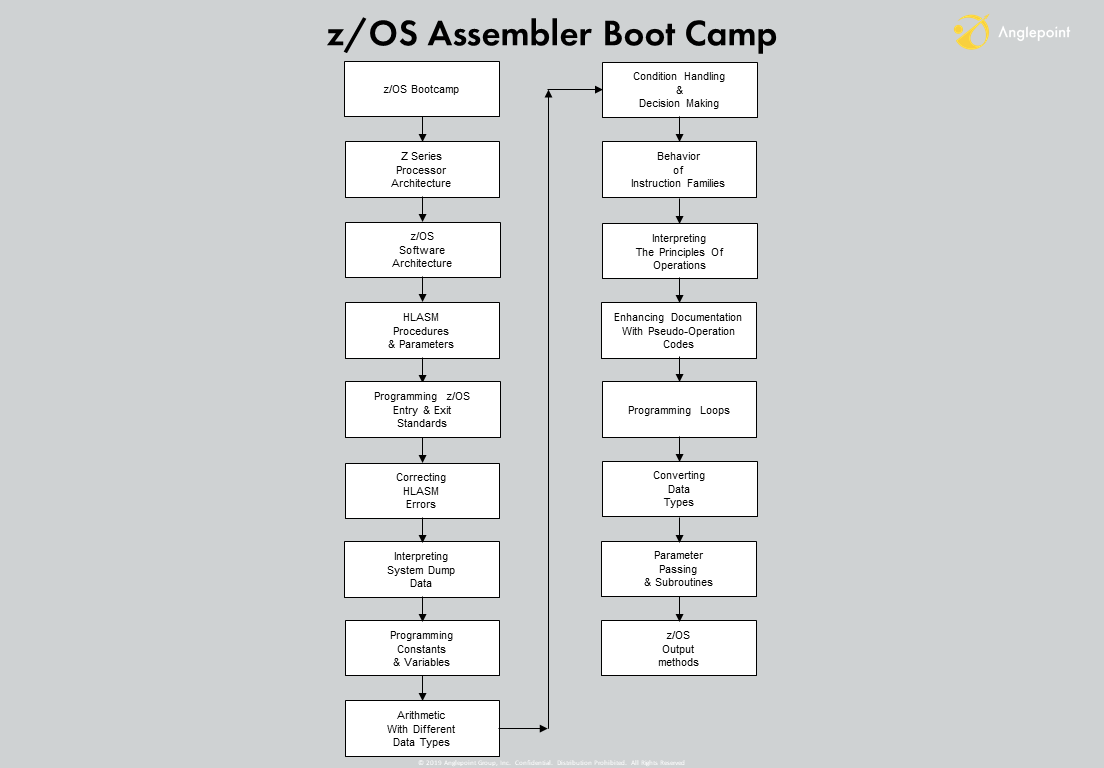Assembler Boot Camp
If you want your future systems programmers to stand out in the crowd you should put them through our Assembler Boot Camp.

Assembler Boot Camp Roadmap
Prerequisite: z/OS Boot Camp
- The z/OS Boot camp or equivalent courses will provide the student with the needed prerequisites to attend the z/OS Assembler Bootcamp
- These prerequisites include:
- Use of ISPF data management utilities to create z/OS library data sets
- Use of the ISPF editor to edit members of these data sets
- Knowledge of JCL to invoke cataloged procedures for HLASM and to override parameters, and add additional DD statements
- Use of SDSF to capture and process output from submitted jobs
Zseries Processor Architecture
- Data types
- Instruction syntax and formats
- Register types
- Storage addressing
- Interrupt codes and types
- Program Status Word
- Storage keys and protection
- Condition codes
z/OS Software Architecture
- Address space components
- Entry and exit conventions
- Save areas
- Parameter passing
- ABEND codes
HLASM Procedures and Parameters
- The catalogued procedures for the HLASM
- Parameters for configuring HLASM behavior
Programming z/OS Entry and Exit Standards
- z/OS registers at entry
- Passing parameters in z/OS
- Register save area chaining
- Registers for returning to your caller
Correcting HLASM Errors
- Format of the assembler listing
- HLASM error message interpretation
- Correcting the source code
Interpreting Symptom Dump Data
- Relating the PSW data to your program
- Using the register values to debug your program
- Converting machine language to HLASM statements
Programming Constants and Variables
- Defining storage areas for variables
- Setting values for constants
- Constant types
Arithmetic with Different Data Types
- Arithmetic instruction families
- Logical arithmetic functions
- Numeric data types
Behavior of Instruction “Families”
- There are several families of instructions, whose behavior is similar. For example, there are different ADD instructions for several different data types. Once you know the behavior of any family member, you can apply that knowledge to the remainder of the family members
- location of the arguments
- which argument(s) receive the result(s)
- which exceptions are applicable
Condition Handling and Decision-Making
- Condition code setting instructions
- The condition code mask
- Instructions that test condition codes
- Branching based on condition codes
Interpreting the Principles of Operation
- The Principles of Operation was written by engineers for engineers
- Principles of Operations Language
- Using the same language constructs to tell how instructions you have not used actually work
Enhancing Documentation with Pseudo-Operation Codes
- Principles of self-documenting code
- Using EQUs to simplify making alterations to code
- Comprehensive use of comments and remarks
- Identity strings and other use of eye-catchers
Programming Loops
- Leading decisions
- Trailing decisions
- Preventing unending loops
- Nested loops
- Use of switches
Converting Data Types
- Making numeric values printable
- Converting numeric text to usable arithmetic format
Parameter Passing and Subroutines
- Fixed and variable-length parameter lists
- Call by name and call by value
- Using subroutines
- CALLing external functions
z/OS Output Methods
- Write-To-Operator and Write-To-Log (WTO and WTL macros)
- Dumping selected storage with SNAP
- Producing a sequential output file with QSAM (Queued Sequential Access Method) macros
- OPEN and CLOSE
- GET and PUT
- DCB (Data Control Block)
